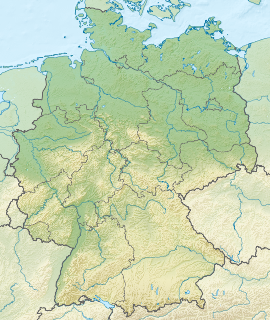
The Sudetes, also known as the Sudeten Mountains or Sudetic Mountains, is a geomorphological subprovince of the Bohemian Massif province in Central Europe, shared by the Czech Republic, Poland and Germany. They consist mainly of mountain ranges and are the highest part of Bohemian Massif. They stretch from the Saxon capital of Dresden in the northwest across to the region of Lower Silesia in Poland and to the Moravian Gate in the Czech Republic in the east. Geographically the Sudetes are a Mittelgebirge with some characteristics typical of high mountains. Its plateaus and subtle summit relief makes the Sudetes more akin to mountains of Northern Europe than to the Alps.

Lusatia is a historical region in Central Europe, territorially split between Germany and modern-day Poland. Lusatia stretches from the Bóbr and Kwisa rivers in the east to the Pulsnitz and Black Elster rivers in the west, and is located within the German states of Saxony and Brandenburg as well as in the Polish voivodeships of Lower Silesia and Lubusz. Major rivers of Lusatia are the Spree and the Lusatian Neisse, which defines the border between Germany and Poland. The Lusatian Mountains of the Western Sudetes separate Lusatia from Bohemia in the south. Lusatia is traditionally divided into Upper Lusatia, the hilly southern part, and Lower Lusatia, the flat northern part.
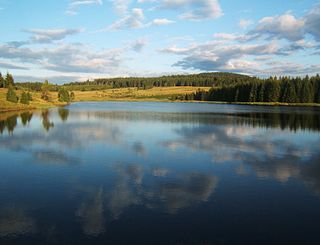
The Ore Mountains lie along the Czech–German border, separating the historical regions of Bohemia in the Czech Republic and Saxony in Germany. The highest peaks are the Klínovec in the Czech Republic at 1,244 metres (4,081 ft) above sea level and the Fichtelberg in Germany at 1,215 metres (3,986 ft).

The Elbe Sandstone Mountains, also called the Elbe Sandstone Highlands, are a mountain range straddling the border between the state of Saxony in southeastern Germany and the North Bohemian region of the Czech Republic, with about three-quarters of the area lying on the German side. In both countries, core parts of the mountain range have been declared a national park. The name derives from the sandstone which was carved by erosion. The river Elbe breaks through the mountain range in a steep and narrow valley.

The Western European broadleaf forests is an ecoregion in Western Europe, and parts of the Alps. It comprises temperate broadleaf and mixed forests, that cover large areas of France, Germany and the Czech Republic and more moderately sized parts of Poland, Austria, Switzerland, Belgium and South Limburg (Netherlands). Luxembourg is also part of this ecoregion.

Liberec District is a district in the Liberec Region of the Czech Republic. Its capital is the city of Liberec.
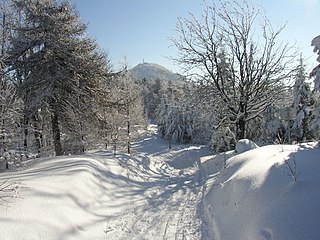
The Lusatian Mountains are a mountain range of the Western Sudetes on the southeastern border of Germany with the Czech Republic. They are a continuation of the Ore Mountains range west of the Elbe valley. The mountains of the northern, German, part are called the Zittau Mountains.

The Šumava National Park, or Bohemian Forest National Park, is a national park in the South Bohemian regions of the Czech Republic along the border with Germany and Austria. They protect a little-inhabited area of the mountain range of the same name, the Šumava or Bohemian Forest.

Děčín District is a district in the Ústí nad Labem Region of the Czech Republic. Its capital is the city of Děčín.

Jizera Mountains, or Izera Mountains, are part of the Western Sudetes on the border between the Czech Republic and Poland. The range got its name from the Jizera River, which rises at the southern base of the Smrk massif. The beech forests within the Jizera Mountains were added to the UNESCO World Heritage Site known as Ancient and Primeval Beech Forests of the Carpathians and Other Regions of Europe, because of their outstanding preservation and testimony to the ecological history of Europe since the Last Glacial Period.

There are several types of protected areas of the Czech Republic. The main form of landscape protection is delimitation of special protected areas. All the types of protected areas are determined by law.

Český les Protected Landscape Area is a protected landscape area in the Czech Republic. It lies in the western part of the Plzeň Region along the border with the German state of Bavaria. It protects the most valuable parts of the Upper Palatinate Forest mountain range.
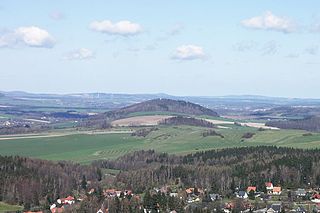
The Breiteberg is a hill in the Lusatian Highlands in Free State of Saxony, Federal Republic of Germany, with an altitude of 510 metres (1,670 ft) above mean sea level. It is the local mountain of Hainewalde, and about half-an-hour's drive from the village. Phonolite covers most of its surface.

The Giant Mountains, Krkonoše, or Karkonosze, are a mountain range located in the north of the Czech Republic and the south-west of Poland, part of the Sudetes mountain system. The Czech–Polish border, which divides the historic regions of Bohemia and Silesia, runs along the main ridge. The highest peak, Sněžka, is the Czech Republic's highest natural point with an elevation of 1,603 metres (5,259 ft).
The Saxon-Bohemian Chalk Sandstone Region is a natural region in south Saxony on the southern border with the Czech Republic.

The Zittau Mountains, formerly also called the Lusatian Ridge, refer to the German part of the Lusatian Mountains that straddle the Saxon-Bohemian border in the extreme southeast of the German state of Saxony.

Hochwald is a mountain on the border of Saxony in southeastern Germany and Bohemia in the Czech Republic. It is at 749.5 metres (2,459 ft) above sea level, one of the highest in the Lusatian/Zittau ranges, directly on the Czech/German border. It has two peaks, the southern main summit, which lies 743.8 metres (2,440 ft) above sea level, and the north summit, which is 370 metres (1,210 ft) away. Due to the visually appealing views from the mountain, it has earned the nickname Aussichtsturm des Zittauer Gebirges.
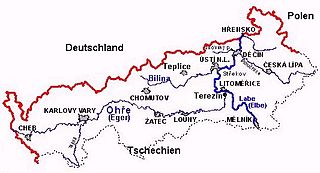
North Bohemia is a region in the north of the Czech Republic.

The Slavkov Forest is a highland and geomorphological mesoregion of the Czech Republic. It is located in the Karlovy Vary Region. Slavkov Forest is also the name of a protected landscape area, partially located within the highland.


